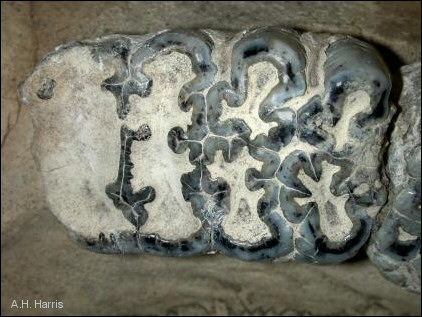

Elephants belong to the taxonomic order called the Proboscidea. If you visualize an elephant and then realize that a proboscis is a nose, you should have a clue as to where the name comes from. For those of you having trouble visualizing, an elephant's trunk is its nose. Through the first half or so of the last ice age, three different families of proboscideans lived in the northern Chihuahuan Desert: gomphotheres, mastodons, and mammoths.
As near as we can judge by their bones, anyone would immediately
identify them as elephant-like. Their teeth, though, tell us that they weren't all
alike. We have a pretty good idea from living animals of what kind of teeth tend to go
with specific kinds of foods. The huge, complex teeth of mammoths are ideal for
withstanding the rapid wear caused by grazing on grasses. Mastodons have relatively
small, simple teeth great for crushing soft leaves, while gomphothere teeth are just a
little more complex for slightly harsher foods. Like so many animals, it looks like
they simply divvied up the food resources.

Contributor: Arthur H. Harris, Laboratory for Environmental Biology, Centennial Museum, University of Texas at El Paso.
Desert Diary is a joint production of the Centennial Museum and KTEP National Public Radio at the University of Texas at El Paso.

A gomphothere second molar. The bluish-gray material is enamel. Wear has been severe
at the anterior end (left), the first part of the tooth to break through the gum and
come under wear. The cream-colored dentine is prominent where the enamel has worn
through. The anterior end of the third molar is visible on the right. Laboratory for
Environmental Biology specimen; photograph by A.H. Harris. © Centennial Museum.
![]()